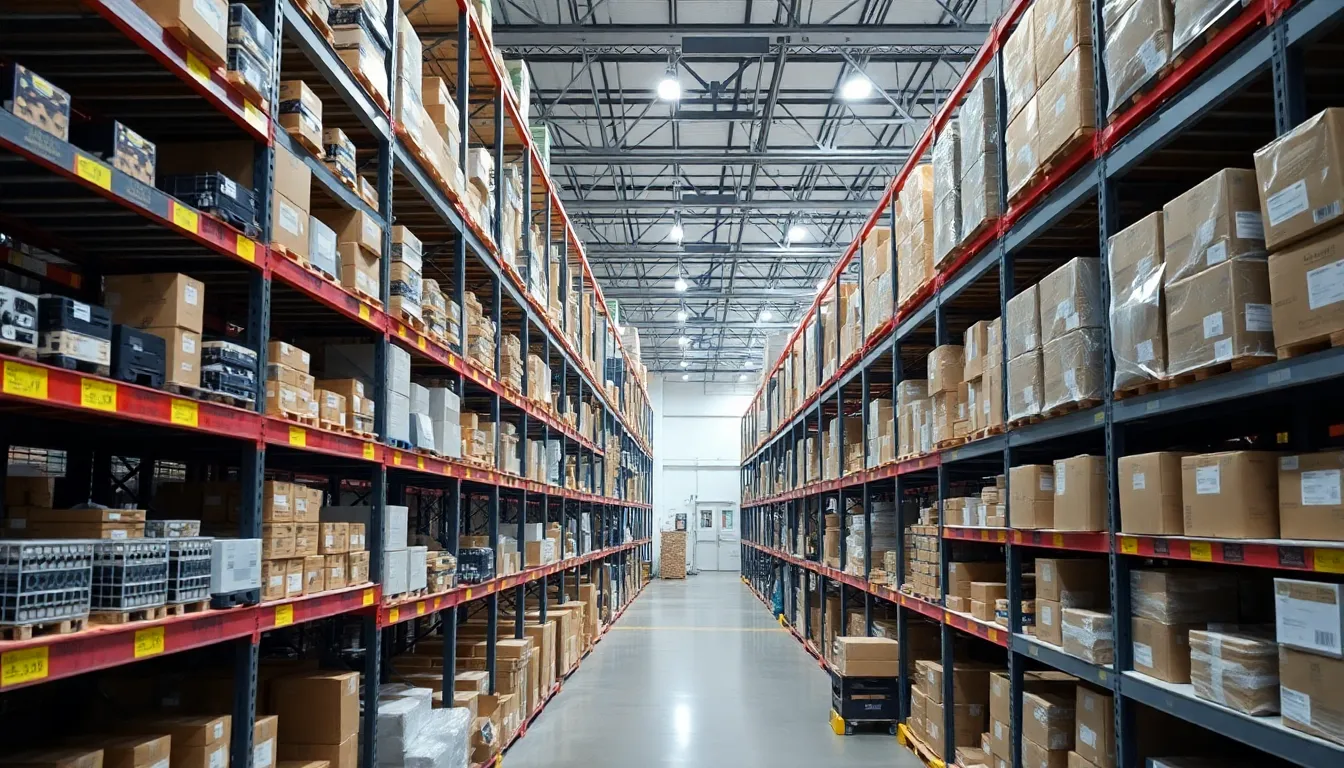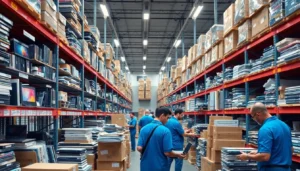In a world where gadgets reign supreme, consumer electronics fulfillment is the unsung hero of the tech universe. Imagine a bustling warehouse filled with the latest smartphones, sleek laptops, and quirky smart home devices, all waiting to find their forever homes. It’s like a techie’s candy store, but instead of sugar highs, customers get the thrill of unboxing their shiny new toys.
But let’s face it: the journey from warehouse to doorstep can be as chaotic as a toddler in a toy store. With rapid advancements and ever-increasing consumer demands, getting products into eager hands is no small feat. That’s where the magic of fulfillment comes in—streamlining the process, ensuring timely deliveries, and keeping customers smiling. So, buckle up as we dive into the world of consumer electronics fulfillment, where efficiency meets excitement and every click brings a little joy.
Table of Contents
ToggleOverview of Consumer Electronics Fulfillment
Consumer electronics fulfillment encompasses the processes involved in delivering tech products to customers efficiently. This area significantly impacts how consumers experience purchasing and receiving their electronics.
Definition and Importance
Consumer electronics fulfillment refers to the entire cycle from order placement to product delivery. It involves warehousing, inventory management, packaging, and shipping. Timely and accurate fulfillment plays a vital role in customer satisfaction. High-quality fulfillment services lead to repeat business and positive reviews, both of which are crucial for brand loyalty in a competitive market. Companies must prioritize these processes to keep pace with rising consumer expectations for fast delivery and impeccable service.
Key Components of the Process
Effective consumer electronics fulfillment includes several key components. Inventory management ensures stock levels align with consumer demand. Order processing involves receiving and confirming orders quickly. Packaging must protect products during transit while also reflecting brand identity. Shipping includes selecting reliable carriers that provide timely delivery options. Returns management addresses product returns efficiently, maintaining customer trust. Each component works collectively to deliver a seamless customer experience and enhance operational efficiency in the fulfillment process.
Supply Chain Management in Consumer Electronics

Supply chain management plays a critical role in consumer electronics, impacting efficiency and customer satisfaction directly. Effective sourcing and procurement strategies influence product availability and pricing.
Sourcing and Procurement
Sourcing forms the backbone of consumer electronics fulfillment. Businesses establish relationships with suppliers to ensure access to high-quality components. Procurement strategies must align with demand, allowing companies to adapt quickly to market changes. Companies often evaluate supplier performance using metrics such as delivery reliability and cost efficiency. Tapping into global supply networks can enhance access to innovative technologies. Prioritizing sustainable sourcing also appeals to environmentally conscious consumers.
Inventory Management
Inventory management optimizes the availability of products while minimizing excess stock. It relies on real-time data to track inventory levels, preventing stockouts and overstock situations. Companies implement automated systems to streamline order fulfillment processes and reduce human error. Forecasting demand accurately ensures that inventory aligns with sales trends. Regular audits maintain inventory accuracy, crucial for operational efficiency. Effective inventory management directly correlates with improved customer satisfaction through timely deliveries and enhanced product availability.
Order Processing and Fulfillment Strategies
Order processing and fulfillment strategies play a vital role in ensuring consumer electronics reach customers efficiently. Streamlined processes enhance customer satisfaction and maintain brand loyalty.
Order Taking and Tracking
Order taking involves capturing customer details accurately and efficiently. Effective systems, like e-commerce platforms and CRM software, simplify this process. Integration of real-time tracking lets customers monitor their orders throughout the fulfillment journey. Tracking information updates instill confidence, as customers see their products move from warehouses to delivery. Automation, utilizing technology, speeds up order processing and minimizes errors. Enhanced communication also builds trust between the business and the customer.
Shipping and Delivery Options
Diverse shipping options cater to varied customer preferences, enhancing satisfaction. Businesses often provide standard, expedited, and same-day shipping choices. Efficient warehousing locations reduce delivery times and shipping costs. Clear communication about shipping fees and delivery estimates informs customers upfront. Also, last-mile delivery, the final leg of the journey, significantly influences overall satisfaction. Collaboration with reliable courier services ensures products arrive on time. Optimizing delivery routes maximizes efficiency and minimizes delays.
Challenges in Consumer Electronics Fulfillment
Challenges in consumer electronics fulfillment impact efficiency and customer satisfaction. Navigating these obstacles is crucial for maintaining a competitive edge in the fast-paced tech industry.
Managing Returns and Exchanges
Managing returns and exchanges presents significant hurdles. High return rates in consumer electronics often arise from product defects or customer dissatisfaction. Implementing effective strategies reduces the burden on fulfillment teams. Developing clear return policies enhances customer trust. Offering hassle-free exchange processes ensures a positive post-purchase experience. Utilizing automated systems streamlines return handling, enabling quicker resolutions. This efficiency ultimately contributes to improved customer loyalty and brand reputation.
Handling Product Variability
Handling product variability necessitates agile inventory management. Variations in product features lead to complexities in tracking and storage. Employing advanced forecasting tools mitigates the impact of unforeseen demand fluctuations. Keeping accurate records of different models assists in maintaining optimal inventory levels. Additionally, leveraging technology facilitates better insights into sales trends. This alignment ensures businesses meet customer preferences while minimizing stockouts and overstock situations. Agile adaptation to product changes enhances overall fulfillment effectiveness and customer satisfaction.
Future Trends in Consumer Electronics Fulfillment
Emerging trends in consumer electronics fulfillment shape the industry. Innovations drive efficiency, customer satisfaction, and strategic operational changes.
Automation and Technology Integration
Automation transforms fulfillment processes in consumer electronics. Systems that automate order processing reduce human error, speeding up deliveries. Robotics in warehouses streamline inventory management and optimize packing operations. Technologies like machine learning enhance demand forecasting accuracy, allowing businesses to adapt quickly to trends. Data analytics enables real-time decision-making, improving overall operational efficiency. Integrating these technologies also leads to cost savings, reducing both labor and operational expenses.
Sustainability Practices
Sustainability practices gain traction in consumer electronics fulfillment. Companies increasingly adopt eco-friendly packaging, reducing plastic waste and carbon footprints. Energy-efficient warehousing technologies minimize resource consumption during operations. Logistics providers focus on optimizing transportation routes, resulting in lower emissions and costs. Additionally, many businesses implement recycling programs for returned products, promoting circular economy principles. Prioritizing sustainability not only meets consumer demand for responsible practices but also enhances brand loyalty among environmentally conscious customers.
Navigating the complexities of consumer electronics fulfillment is essential for businesses aiming to thrive in a competitive landscape. By prioritizing efficient processes and leveraging technology, companies can enhance customer satisfaction and loyalty. The integration of automation and sustainable practices not only streamlines operations but also meets the evolving demands of consumers.
As the industry continues to adapt to rapid changes, staying ahead of trends will be crucial. Embracing innovative fulfillment strategies ensures that businesses can deliver the latest gadgets promptly and reliably. Ultimately, a commitment to excellence in fulfillment can set brands apart and foster lasting relationships with customers.



